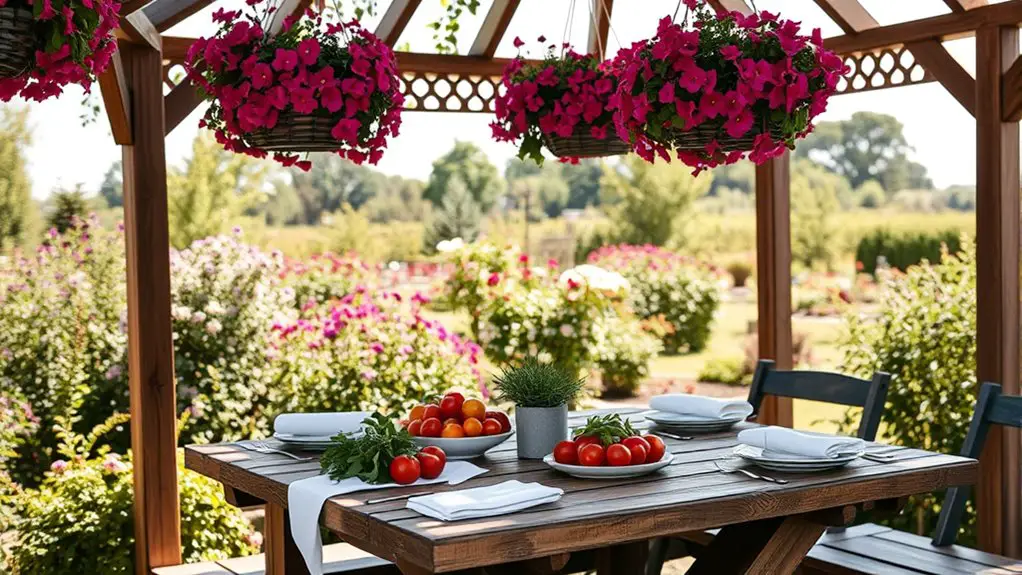To plan a cooking class under your gazebo, start by choosing a date with pleasant weather. Select an exciting theme and prepare a menu focusing on seasonal ingredients. Set up your gazebo efficiently, ensuring a central cooking station and proper ventilation. Equip yourself with essential cooking tools and create a comfortable atmosphere with lighting. Don’t forget to manage RSVPs smoothly and engage participants during the class. Continue to explore ways to enhance your event for even more success.
Choosing the Right Date and Time
When should you schedule your cooking class to attract the most participants? First, consider weather considerations. If you’re hosting under a gazebo, aim for a day with pleasant temperatures and clear skies. Spring and early fall often provide ideal conditions, allowing guests to enjoy the outdoors without discomfort.
Next, think about guest availability. Weekends typically work best, as many people have more free time. However, don’t overlook weekday evenings, especially if you’re targeting busy professionals looking for a fun mid-week escape.
Be mindful of local events or holidays that may affect attendance. You want your cooking class to be a leisurely experience, so avoid scheduling it during peak vacation seasons when potential participants might be away. By carefully choosing your date and time, you’ll create an inviting atmosphere that encourages freedom and creativity in the kitchen. Additionally, hosting your class under a gazebo can enhance outdoor comfort and provide a pleasant setting for culinary exploration.
Selecting a Theme for Your Cooking Class
When selecting a theme for your cooking class, consider the seasonal ingredients available to you; they can inspire creativity and freshness in your menu. You might also think about the type of cuisine you want to explore, whether it’s Italian, Thai, or a fusion of flavors. A well-chosen theme not only engages participants but also enhances their culinary experience.
Seasonal Ingredient Inspiration
Choosing a seasonal ingredient theme for your cooking class can enhance the experience for both you and your students, as it allows everyone to connect with the freshest flavors available. By collaborating with local farmers, you can guarantee your ingredient showcase features the best seasonal produce selection. This farm-to-table approach not only supports sustainable sourcing but also introduces students to vibrant, seasonal flavors. Incorporate fresh herbs to elevate dishes and explore various cooking techniques that highlight these ingredients. Whether you’re crafting salads, sauces, or mains, the focus on seasonal ingredients fosters creativity and a deeper appreciation for the culinary arts. Ultimately, this theme sets the stage for a memorable class where students feel empowered and inspired.
Cuisine Type Selection
Building on the inspiration from seasonal ingredients, selecting a cuisine type for your cooking class can elevate the experience even further. Think about diving into Italian cuisine, where rich flavors and fresh herbs create a comforting atmosphere. If you’re craving something bold, explore Asian flavors—think vibrant stir-fries or aromatic curries. For a lighter touch, Mediterranean dishes with their emphasis on vegetables and olive oil can be invigorating. Don’t forget to reflect on vegan options, ensuring everyone can join in. Comfort foods are always a hit, evoking nostalgia and warmth. Finally, end on a sweet note with dessert specialties that leave a lasting impression. Ultimately, choose a theme that excites you and your participants, allowing creativity to flow freely!
Preparing the Menu and Ingredients
When preparing your cooking class menu, focus on seasonal ingredients to guarantee freshness and flavor. Simple recipe ideas will not only keep your participants engaged but also make it easier for them to replicate the dishes at home. By combining these elements, you’ll create an enjoyable and rewarding cooking experience for everyone involved.
Seasonal Ingredient Selection
To create a memorable cooking class experience, selecting seasonal ingredients is essential, as they not only enhance flavor but also celebrate the time of year. Start by visiting local farmers’ markets to find fresh, seasonal produce that showcases the best your region has to offer. Think vibrant tomatoes in summer, hearty squashes in fall, or crisp greens in spring. By choosing ingredients that are in season, you support local farmers and reduce your carbon footprint. Consider the flavor profiles of these ingredients; they’ll inspire your menu and make your dishes shine. Engaging with the community also adds a personal touch, inviting participants to appreciate the connection between food, seasons, and the environment in a fun, relaxed setting.
Simple Recipe Ideas
Creating a successful cooking class starts with choosing simple, engaging recipes that cater to various skill levels. Begin with quick appetizers like bruschetta or caprese skewers, which are easy to assemble and packed with flavor. These will get everyone in the mood and spark conversation. For the main course, consider a customizable pasta bar; guests can choose from different sauces, veggies, and proteins, making it interactive and fun. Don’t forget dessert options! Mini fruit tarts or no-bake cheesecake bites are perfect for satisfying sweet cravings without overwhelming your guests. Keep the ingredients fresh and seasonal, allowing participants to explore flavors while expressing their culinary creativity. With these ideas, your cooking class will be a delightful experience for everyone involved!
Setting Up Your Gazebo for Cooking
Setting up your gazebo for cooking can transform an ordinary outdoor space into a culinary haven. Start by considering your gazebo layout to maximize efficiency and comfort. Position your cooking station in the center, ensuring you have enough room to move around while cooking. Set up tables for ingredients and serving, and don’t forget about outdoor lighting to create a warm atmosphere during evening classes. It’s also crucial to ensure proper ventilation to reduce smoke and gas buildup when using grills.
Here’s a simple layout you can follow:
| Area | Purpose | Notes |
|---|---|---|
| Cooking Station | Main cooking area | Central location |
| Ingredient Table | Prep your ingredients | Close to cooking area |
| Serving Table | Display finished dishes | Easily accessible |
| Seating Area | Participants’ comfort | Comfortable chairs |
| Lighting | Ambiance | String lights or lanterns |
With this setup, you’ll inspire creativity and make cooking an enjoyable experience for everyone involved!
Essential Cooking Equipment and Utensils
While planning your cooking class, it’s crucial to have the right equipment and utensils at your fingertips to guarantee a smooth and enjoyable experience. Start with the essential tools: sharp knives, cutting boards, and mixing bowls. These are your staples, allowing for efficient prep work. Don’t forget measuring cups and spoons; precision is key in cooking.
Next, gather necessary gadgets like peelers, whisks, and spatulas. These will add versatility to your class, helping participants explore various techniques. A sturdy pot and a non-stick pan are must-haves for cooking different recipes.
Consider a portable grill or hot plate if you’re cooking outdoors. Finally, keep your workspace tidy with a trash bowl for scraps; it’ll keep everyone focused and engaged. With these tools in hand, you’ll create a dynamic cooking environment that encourages creativity and enjoyment.
Inviting Guests and Managing RSVPs
Once you’ve gathered all the necessary equipment and utensils for your cooking class, it’s time to focus on inviting your guests and managing RSVPs. A well-organized guest list can elevate your class and guarantee a delightful experience for everyone involved. Here are some tips to help you with RSVP management:
Once your cooking class essentials are ready, prioritize inviting guests and managing RSVPs for a smooth, enjoyable experience.
- Craft an inviting invitation that captures the essence of your cooking class.
- Set a clear RSVP deadline so you can plan accordingly and minimize last-minute surprises.
- Use a simple RSVP method, like a Google Form or a dedicated email, to keep track of responses effortlessly.
- Follow up with non-respondents to confirm attendance and gauge interest.
Creating a Comfortable Atmosphere
Creating a comfortable atmosphere in your cooking class can greatly enhance the experience for all participants. Consider the following lighting options and seating arrangements to set the perfect mood.
| Lighting Options | Seating Arrangements |
|---|---|
| Soft string lights | Round tables for discussion |
| Warm, dimmable lamps | Casual seating with cushions |
| Natural sunlight | High-top tables for mingling |
| Candles for ambiance | Flexible seating for movement |
Choose lighting that complements your gazebo’s natural charm while providing adequate visibility. Soft, warm lights can create an inviting ambiance, while natural sunlight brings energy to the space. For seating, round tables foster interaction, encouraging conversation and teamwork. Don’t forget to add comfortable cushions or flexible seating options, allowing participants to move around freely. Overall, aim for a relaxed vibe where everyone feels at ease and inspired to cook together. Incorporating outdoor lighting options can enhance the overall decor and atmosphere, making the experience even more enjoyable.
Tips for Teaching and Engaging Participants
A relaxed atmosphere sets the stage for effective teaching and participant engagement. To create a memorable cooking class, keep your participants involved and excited. Here are some tips to enhance their experience:
- Incorporate interactive activities: Hands-on tasks keep everyone engaged and learning actively.
- Encourage questions: Foster an open dialogue to build confidence and camaraderie among participants.
- Use visuals: Demonstrating techniques or showing finished dishes can inspire creativity and understanding.
- Create small groups: Break participants into smaller teams for collaborative cooking, boosting social interaction and teamwork.
Post-Class Cleanup and Follow-Up
While the excitement of the cooking class may linger, it is crucial to address post-class cleanup and follow-up to guarantee a seamless experience. Start by implementing effective cleanup strategies. Enlist participants to help with washing dishes and wiping down surfaces, creating a sense of community even during cleanup. Consider setting up designated stations for trash, recycling, and composting to streamline the process.
Once everything’s tidy, take a moment to gather feedback. Send a follow-up email thanking everyone for attending and asking for their thoughts on the class. You could include a quick survey to capture insights on what they enjoyed and what could be improved. This feedback loop not only enhances future classes but also fosters a connection with your participants. Remember, a little effort in cleanup and follow-up can transform a one-time event into a memorable experience that they’ll want to revisit!
Frequently Asked Questions
What Is the Ideal Number of Participants for a Cooking Class?
Did you know that classes with 8-12 participants often yield the best group dynamics? This size enhances participant engagement, allowing for interaction and hands-on experience, making your cooking class enjoyable and memorable for everyone involved.
How Can I Accommodate Dietary Restrictions for Attendees?
To accommodate dietary restrictions, you should offer vegan options and gluten-free substitutes. By being mindful of attendees’ needs, you’ll create an inclusive atmosphere that encourages everyone to enjoy their culinary experience without limitations.
Do I Need Insurance for Hosting a Cooking Class?
When hosting a cooking class, it’s wise to contemplate liability coverage or event insurance. This protects you from potential mishaps, ensuring you can focus on creativity and freedom while sharing your culinary passion with others.
What Weather Considerations Should I Keep in Mind?
Weather’s a fickle friend, isn’t it? For your class, consider rain protection like a trusty umbrella; temperature control is key too. You wouldn’t want your soufflé to melt or your guests to freeze, would you?
How Much Should I Charge for the Cooking Class?
When considering how much to charge, factor in your pricing strategies and the cost of class materials. Research similar classes in your area, ensuring you strike a balance between accessibility and fair compensation for your expertise.

